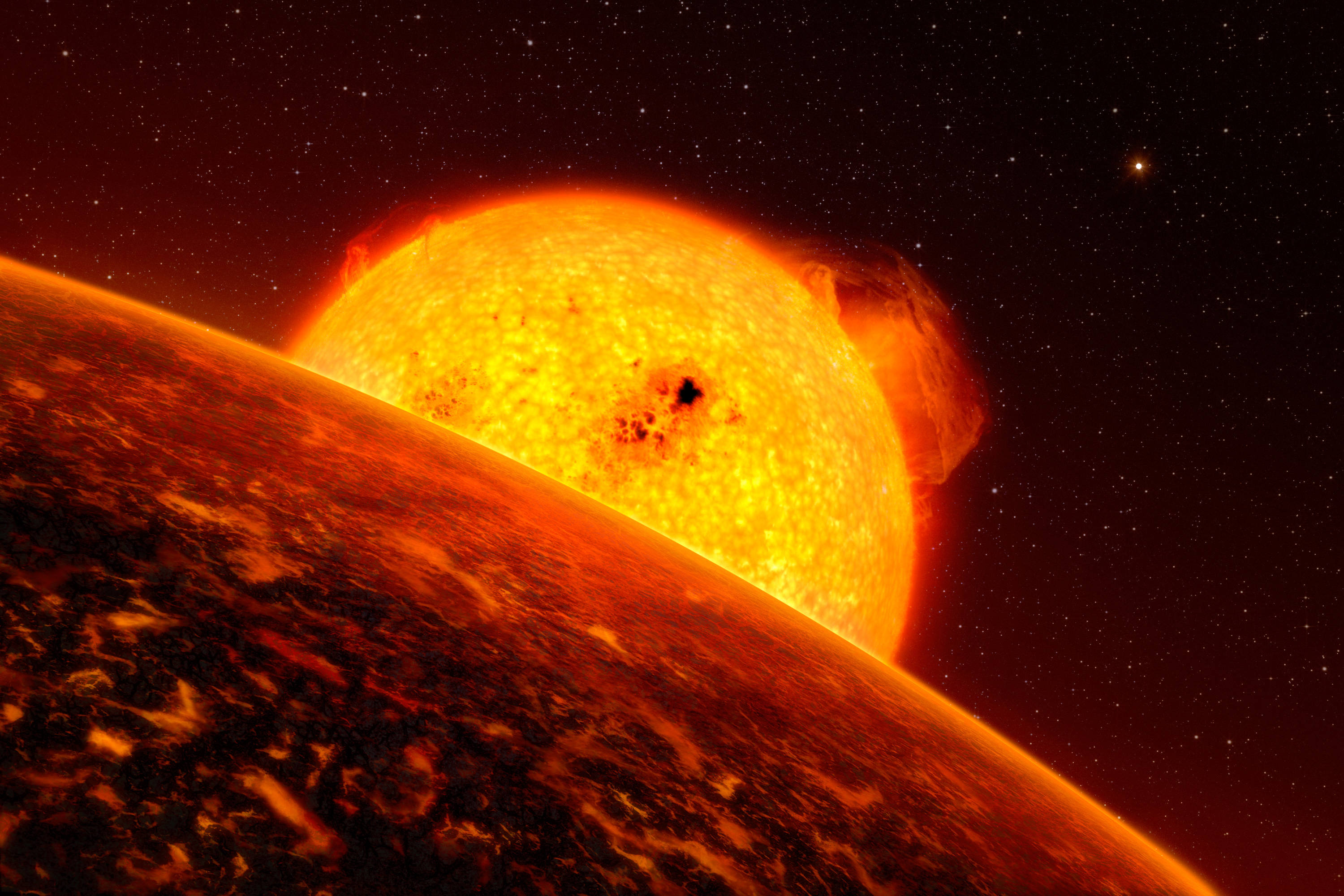Lava-ocean Planet on:
[Wikipedia]
[Google]
[Amazon]
 A lava planet is a type of terrestrial planet, with a surface mostly or entirely covered by molten lava. Situations where such planets could exist include a young terrestrial planet just after its formation, a planet that has recently suffered a large collision event, or a planet orbiting very close to its
A lava planet is a type of terrestrial planet, with a surface mostly or entirely covered by molten lava. Situations where such planets could exist include a young terrestrial planet just after its formation, a planet that has recently suffered a large collision event, or a planet orbiting very close to its
Lava Worlds: From Early Earth to Exoplanets
Keng-Hsien Chao, Rebecca deGraffenried, Mackenzie Lach, William Nelson, Kelly Truax, Eric Gaidos, 14 Dec 2020 {{Portal bar, Astronomy, Space * Types of planet
 A lava planet is a type of terrestrial planet, with a surface mostly or entirely covered by molten lava. Situations where such planets could exist include a young terrestrial planet just after its formation, a planet that has recently suffered a large collision event, or a planet orbiting very close to its
A lava planet is a type of terrestrial planet, with a surface mostly or entirely covered by molten lava. Situations where such planets could exist include a young terrestrial planet just after its formation, a planet that has recently suffered a large collision event, or a planet orbiting very close to its star
A star is an astronomical object comprising a luminous spheroid of plasma (physics), plasma held together by its gravity. The List of nearest stars and brown dwarfs, nearest star to Earth is the Sun. Many other stars are visible to the naked ...
, causing intense irradiation and tidal forces.
Factors and characteristics
Lava planets would probably orbit extremely close to their parent star. In planets with eccentric orbits, the gravity from the nearby star would distort the planet periodically, with the resulting friction producing internal heat. This tidal heating could melt rocks into magma, which would then erupt through volcanoes. This would be similar to the Solar System moon Io, orbiting close to its parent Jupiter. Io is the most geologically active world in the Solar System, with hundreds of volcanic centres and extensive lava flows. Lava worlds orbiting extremely closely to the parent star may possibly have even more volcanic activity than Io, leading some astronomers to use the term ''super-Io''. These "super-Io" exoplanets may resemble Io with extensive sulfur concentrated on their surfaces that is associated with the continuous active volcanism. However, tidal heating is not the only factor shaping a lava planet. In addition to tidal heating from orbiting close to their parent star, the intense stellar irradiation could melt the surface crust directly into lava. The entire star-facing surface of a tidally locked planet could be left covered in a lava ocean while the nightside may have lava lakes, or even lava rain caused by the condensation of vaporized rock from the dayside. The mass of the planet would also be a factor. The appearance of plate tectonics on terrestrial planets is related to planetary mass, with more massive planets than Earth expected to exhibit plate tectonics and thus more intense volcanic activity. Also, aMega Earth
A mega-Earth is a proposed neologism for a massive terrestrial exoplanet that is at least ten times the mass of Earth. Mega-Earths would be substantially more massive than super-Earths (terrestrial and ocean planets with masses around 5–10 Ea ...
may retain so much internal heat from its formation that a solid crust cannot form.
Protoplanets tend to have intense volcanic activity resulting from large amounts of internal heating just after formation, even relatively small planets that orbit far from their parent stars. Lava planets can also result from giant impacts; Earth was briefly a lava planet after being impacted by a Mars-sized body which formed the Moon.
A 2020 preprint
In academic publishing, a preprint is a version of a scholarly or scientific paper that precedes formal peer review and publication in a peer-reviewed scholarly or scientific journal. The preprint may be available, often as a non-typeset versio ...
study finds that lava planets have low geometric albedos of around 0.1 and that molten lava on the surface can cool and harden to form quenched glass
In materials science, quenching is the rapid cooling of a workpiece in water, oil, polymer, air, or other fluids to obtain certain material properties. A type of heat treating, quenching prevents undesired low-temperature processes, such as phas ...
.
Candidates
There are no known lava worlds in the Solar System and the existence of extrasolar lava planets remains unknown. Several known exoplanets are likely lava worlds, given their small enough masses, sizes, and orbits. Likely lava exoplanets includeCOROT-7b
CoRoT-7b (previously named CoRoT-Exo-7b) is an exoplanet orbiting the star CoRoT-7 in the constellation of Monoceros, from Earth. It was first detected photometrically by the French-led CoRoT mission and reported in February 2009. Until the anno ...
, Kepler-10b, and Kepler-78b.
See also
* Chthonian planet * List of planet types * Magma ocean *Mustafar
Mustafar () is a fictional volcanic and lava planet in the ''Star Wars'' franchise. Introduced in the final prequel film, ''Revenge of the Sith'' (2005), it also appeared in the films ''Rogue One'' (2016) and ''Episode IX – The Rise of Skywal ...
(fictional planet)
* Lava planets in science fiction
References
Further reading
Lava Worlds: From Early Earth to Exoplanets
Keng-Hsien Chao, Rebecca deGraffenried, Mackenzie Lach, William Nelson, Kelly Truax, Eric Gaidos, 14 Dec 2020 {{Portal bar, Astronomy, Space * Types of planet